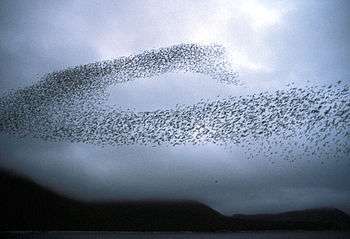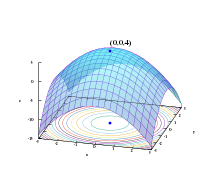Cuckoo search
In operations research, cuckoo search is an optimization algorithm developed by Xin-she Yang and Suash Deb in 2009.[1][2] It was inspired by the obligate brood parasitism of some cuckoo species by laying their eggs in the nests of other host birds (of other species). Some host birds can engage direct conflict with the intruding cuckoos. For example, if a host bird discovers the eggs are not their own, it will either throw these alien eggs away or simply abandon its nest and build a new nest elsewhere. Some cuckoo species such as the New World brood-parasitic Tapera have evolved in such a way that female parasitic cuckoos are often very specialized in the mimicry in colors and pattern of the eggs of a few chosen host species [3] Cuckoo search idealized such breeding behavior, and thus can be applied for various optimization problems.
Metaphor
Cuckoo search (CS) uses the following representations:
Each egg in a nest represents a solution, and a cuckoo egg represents a new solution. The aim is to use the new and potentially better solutions (cuckoos) to replace a not-so-good solution in the nests. In the simplest form, each nest has one egg. The algorithm can be extended to more complicated cases in which each nest has multiple eggs representing a set of solutions.
CS is based on three idealized rules:
- Each cuckoo lays one egg at a time, and dumps its egg in a randomly chosen nest;
- The best nests with high quality of eggs will carry over to the next generation;
- The number of available hosts nests is fixed, and the egg laid by a cuckoo is discovered by the host bird with a probability . Discovering operate on some set of worst nests, and discovered solutions dumped from farther calculations.
In addition, Yang and Deb discovered that the random-walk style search is better performed by Lévy flights rather than simple random walk.
Algorithm
The pseudo-code can be summarized as:
Objective function: Generate an initial population of host nests; While (t<MaxGeneration) or (stop criterion) Get a cuckoo randomly (say, i) and replace its solution by performing Lévy flights; Evaluate its quality/fitness [For maximization, ]; Choose a nest among n (say, j) randomly; if ( ), Replace j by the new solution; end if A fraction ( ) of the worse nests are abandoned and new ones are built; Keep the best solutions/nests; Rank the solutions/nests and find the current best; Pass the current best solutions to the next generation; end while
An important advantage of this algorithm is its simplicity. In fact, comparing with other population- or agent-based metaheuristic algorithms such as particle swarm optimization and harmony search, there is essentially only a single parameter in CS (apart from the population size ). Therefore, it is very easy to implement.
Random walks and the step size
An important issue is the applications of Lévy flights and random walks in the generic equation for generating new solutions
where is drawn from a standard normal distribution with zero mean and unity standard deviation for random walks, or drawn from Lévy distribution for Lévy flights. Obviously, the random walks can also be linked with the similarity between a cuckoo's egg and the host's egg which can be tricky in implementation. Here the step size determines how far a random walker can go for a fixed number of iterations. The generation of Lévy step size is often tricky, and a comparison of three algorithms (including Mantegna's[4]) was performed by Leccardi[5] who found an implementation of Chambers et al.'s approach[6] to be the most computationally efficient due to the low number of random numbers required.
If s is too large, then the new solution generated will be too far away from the old solution (or even jump outside of the bounds). Then, such a move is unlikely to be accepted. If s is too small, the change is too small to be significant, and consequently such search is not efficient. So a proper step size is important to maintain the search as efficient as possible.
As an example, for simple isotropic random walks, we know that the average distance traveled in the d-dimension space is
where is the effective diffusion coefficient. Here is the step size or distance traveled at each jump, and is the time taken for each jump. The above equation implies that[7]
For a typical length scale L of a dimension of interest, the local search is typically limited in a region of . For and t=100 to 1000, we have for d=1, and for d=10. Therefore, we can use s/L=0.001 to 0.01 for most problems. Though the exact derivation may require detailed analysis of the behaviour of Lévy flights.[8]
Algorithm and convergence analysis will be fruitful, because there are many open problems related to metaheuristics[9]
References
- ↑ X.-S. Yang; S. Deb (December 2009). Cuckoo search via Lévy flights. World Congress on Nature & Biologically Inspired Computing (NaBIC 2009). IEEE Publications. pp. 210–214. arXiv:1003.1594v1.
- ↑ Inderscience (27 May 2010). "Cuckoo designs spring". Alphagalileo.org. Retrieved 2010-05-27.
- ↑ R. B. Payne, M. D. Sorenson, and K. Klitz, The Cuckoos, Oxford University Press, (2005).
- ↑ R. N. Mantegna, Fast, accurate algorithm for numerical simulation of Lévy stable stochastic processes, Physical Review E, Vol.49, 4677-4683 (1994).
- ↑ M. Leccardi, Comparison of three algorithms for Levy noise generation, Proceedings of fifth EUROMECH nonlinear dynamics conference (2005).
- ↑ Chambers, J. M.; Mallows, C. L.; Stuck, B. W. (1976). "A method for simulating stable random variables". Journal of the American Statistical Association. 71: 340–344. doi:10.1080/01621459.1976.10480344.
- ↑ X.-S. Yang, Nature-Inspired Metaheuristic Algorithms, 2nd Edition, Luniver Press, (2010).
- ↑ M. Gutowski, Lévy flights as an underlying mechanism for global optimization algorithms, ArXiv Mathematical Physics e-Prints, June, (2001).
- ↑ X. S. Yang, Metaheuristic optimization: algorithm analysis and open problems, in: Experimental Algorithms (SEA2011), Eds (P. M. Pardalos and S. Rebennack), LNCS 6630, pp.21-32 (2011).

